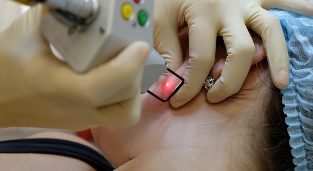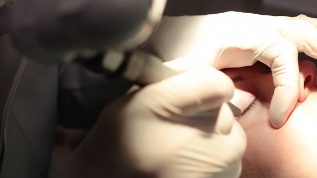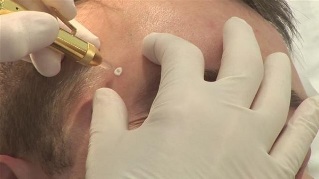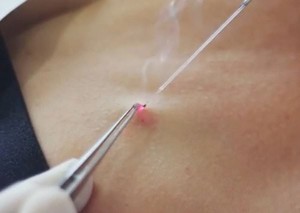
Laser removal of neoplasms is a very common and effective procedure that helps get rid of unwanted growth. This is a relatively new method, which appeared in the Medical Arsenal not so long ago, but has already proven its advantage over other methods of removing it. The precursors were removed before laser destruction by using liquid nitrogen, electricity, or a scalpel. All of this can cause the patient significant discomfort, and laser removal shows good results with painless intervention.
Why remove
Papillomas are usually benign neoplasms, which grow in different shapes and sizes. They are localized on the mucous membranes of the wearer or on their skin. The main reason for their appearance is the action of the human papillomavirus virus, which in most cases is sexually transmitted.
It performs several tasks at the same time to remove these buildings:
- Aesthetic correction.A growing patient may feel uncomfortable and get too much attention from others. Because of this, a person may feel insecure and uncomfortable, even if the growth is not a danger to him.
- Injury prevention.If the growth is in a traumatic place where the patient is constantly in contact with it, this can separate the protruding part. In addition, when trying to cover the papilloma with clothes, there may be such a problem and rubbing the affected area. This is accompanied by injury to the papilloma and subsequent possible infection. The damage can turn into microbes, which can cause inflammation in the wound. If this happens, the damaged area must be treated with peroxide and immediately go to the clinic to remove the rest of the papilloma.
- Reducing the risk of cancer.Despite the fact that growths are harmless in nature, such manifestations are different from warts. They are usually located in intimate areas and pose a high risk of developing cancer. To prevent the disease, all warts must be removed.
Do not remove the build yourself. Any attempt to attach papilloma to a thread, comb, chemical agent of some kind can lead to a deterioration of its condition.
Advantages of the procedure
Laser erasing has several advantages over other methods of removing it.These include:
- Guaranteed result. The device is able to go deep enough to clear all traces of the presence of a neoplasm.
- Without pain.Exposure to the laser gives the patient the least pain. If you add the pre-anesthesia procedure with a local anesthetic, there is no pain.
- Speed of the procedure. Laser removal of papillomas requires 2 to 5 minutes per element.
- Non-invasive.The laser beam is in a strictly confined area and does not go beyond it. In this case, no more than one part of the laser touches the site of the procedure. This is very important, because this method helps to minimize the risk of infection and gives a high sterile guarantee.
- No postoperative scars.If the work is done correctly, there should be no trace of the laser action in the exposed area. This happens because the affected tissue is completely evaporated, and then a new, intact skin takes its place.
- Bloodless way to destroy.The laser beam heats the capillaries that supply blood, and quickly seals their walls. As a result, bleeding stops and does not resume after surgery.
- Suitable for various parts of the body.Not all transfer methods can be used on all parts of the body. Personal areas, eyelids, etc. are considered. Very sensitive. Laser erasing does a good job of dealing with growths in such areas due to the accuracy of the laser beam.
Because of all these factors, laser removal is one of the most popular procedures for removing growths.
Contraindications
The list of violations of this procedure is not as long as other deletion methods.Prohibitions on laser removal include:
- diabetes
- diabetes mellitus; oncology
- ; Increased chronic diseases
- ; titimeas
- ; Diseases
- associated with endocrine system problems;
- poor blood clotting;
- HIV or AIDS;
- acute inflammatory diseases.
In addition, patients with influenza or acute respiratory infections should be delayed for some time.
Description of the procedure
Before starting any procedure to remove the growths, the doctor will decontaminate the area on which he will be operating. In some cases, a local anesthetic is used. An ointment or sprayer is usually used for this purpose. After applying the anesthetic drug, 2-3 minutes pass, and the transfer process begins.

The laser beam is focused on the affected area and, as it were, warns of unwanted growth. At this moment, the contents of the cells are evaporated under the influence of the laser, removing all layers of the tissue involved. This happens not only in easily accessible places in open spaces. The procedure is to remove papilloma, for example, on the eyelid. The only nuance in this area is that a special cooling method is used for the patient to prevent pain and burns at this sensitive point.
Neoplasms are removed in intimate areas according to the same principle. But here the doctor usually uses an anesthetic injection as an anesthetic, injecting the growth from different angles.The very large moment of inserting a needle can be painful, but after a few minutes the sensitivity in the affected area disappears completely, and additional manipulations are completely painless.
The affected area turns into a small bloodless wound. At the time of destruction, it is disinfected due to the work of the laser. After removing the erection, the doctor treats the affected area with potassium permanganate.
After the procedure, the patient may have slight redness, itching or mild soreness at the site where the papilloma is removed.
This reaction is considered normal, since, despite the non-invasiveness of the procedure, the integrity of the skin was compromised during the operation.All discomfort should completely disappear 2-4 days after the procedure.
A dry crust appears later over the wound. Underneath that is a layer of skin that is already healthy, so its protective shell cannot be tightened until it falls off on its own. Otherwise, a scar may remain on the skin, and the healing process itself may take longer.
Consequences
Laser deletion is rare. Its presence is usually associated with diseases that the patient already has, which he did not cure before the procedure. So, for example, if the patient had skin inflammation, it may contribute to the appearance of the pigment. If the skin itself is very sensitive, a slight reddening may be associated with burns. With a high allergic reaction, edema may occur at the site of exposure.
To exclude all undesirable effects, it is necessary to consult a doctor before laser erasure.Care after the procedure
After removal of the erection, the patient must adhere to the following rules:
- do not allow
- water to enter the wound for 2-3 days;
- refrains from visiting saunas, baths and swimming pools; Do not
- rub the damaged area with a towel; Do not use
- adhesive plaster on the wound;
- does not treat the papilloma removal site with scrub, lotions containing alcohol; avoid
- exposure to ultraviolet rays.
Several times a day, the wound needs antiseptic treatment. This must be done until the moment the scab is removed. This treatment should prevent infection and help speed up the time of complete healing.To treat the damaged area, you can take iodine or a solution of potassium permanganate.
After the transfer site is treated with anti-inflammatory ointments.
Their action is aimed at accelerating tissue regeneration, alleviating inflammation and edema. Before choosing a particular medicine, it is best to consult a doctor.
Which method is best
Laser removal is not the only way to deal with unwanted growth. There are other ways too, which stand out among them:

Cryodestruction.
Based on removal of papillomas with liquid nitrogen. Due to exposure to low temperatures, the construction begins to fall apart and eventually disappears completely. The method is effective, but has some drawbacks. Among them, it is impossible to fully control the depth of nitrogen activity. The substance can pass deep, without touching a healthy area, or, conversely, affect it superficially, without affecting all layers of the localization of the building.
In addition, this method is characterized by:
- the possibility of postoperative scars; painful sensations
- ; Inability to
- guarantee the result after the first procedure.
Thus, laser deletion shows greater efficiency compared to cross-construction. Laser pain is less painful and is more likely to guarantee the desired result.
Radio wave removal.
This method of destruction is performed using a special device that acts on the papilloma by radio waves. This promotes the build up due to the point effect of the radio knife. The accuracy of the procedure is very high, so that the nearby tissues are not affected. However, the risk of burns or infections is very low.
This method is suitable for removing small, benign lesions. It is very effective, which makes it as common as laser destruction. Both methods of removing papillomas are considered to be modern approaches and are equally used in medicine.

Electrocoagulation.
This method is based on the action of high-frequency electric current acting on the papilloma directly at the site of the lesion. Electro-heating is now considered a common but outdated method. This method allows you to prevent bleeding after removal of the papilloma by burning the vessels.
However, when using a high-frequency stream, patients experience pain that is visible even after anesthesia. This leads some patients to undergo electromyography, opting for laser removal as a more advanced and painless method.Estimated Cost
The price range depends not only on the region and clinic where the harvest is carried out, but also on the number, size and location of growths harvested.
In many clinics there is a discount for new growth in bulk: the more a patient has, the cheaper it will be to extract one growth.
Getting rid of growth in the genital area can be much more expensive than on other parts of the body. Moreover, not all clinics provide such a service due to the complexity of such manipulation.














































































